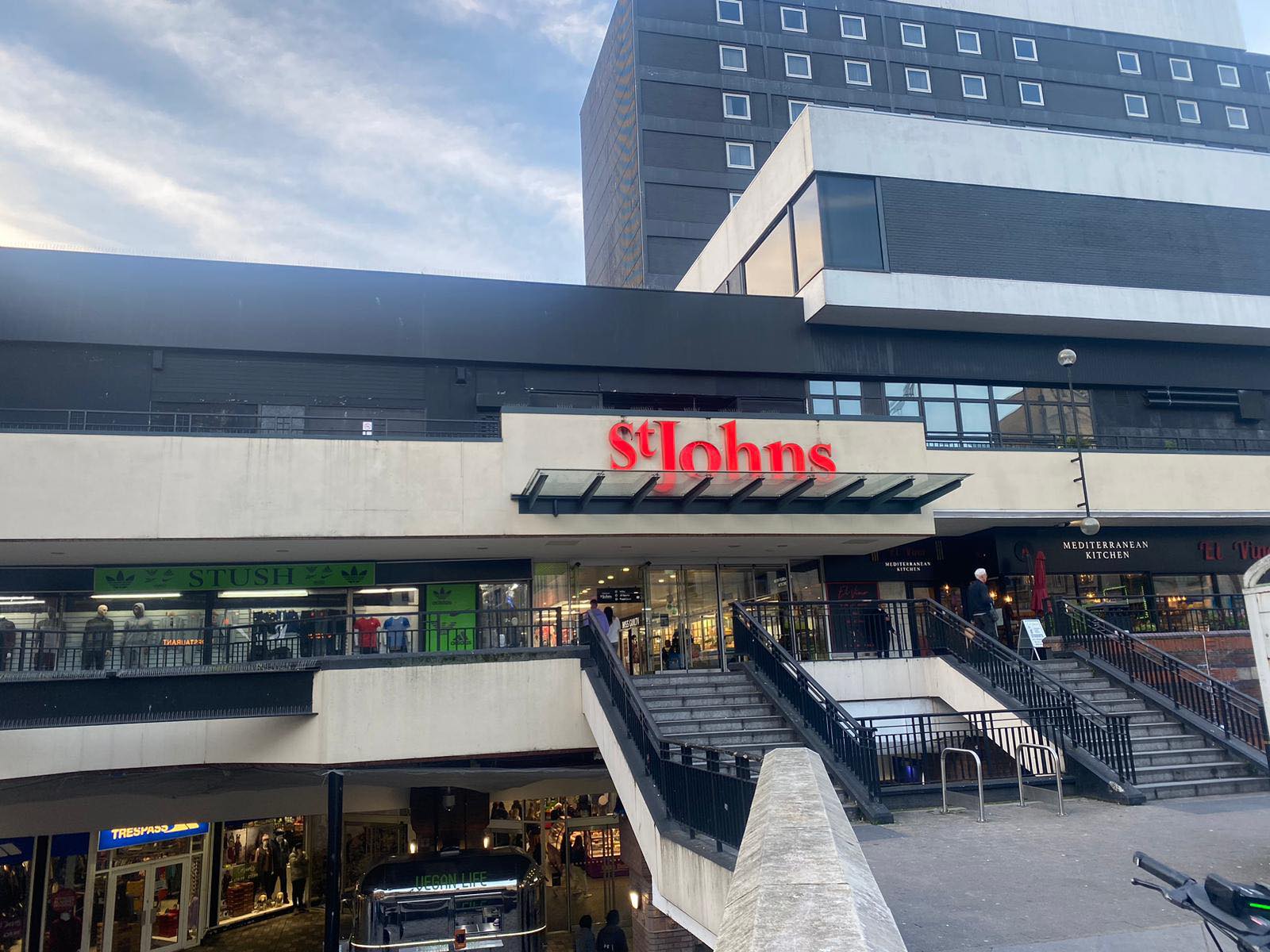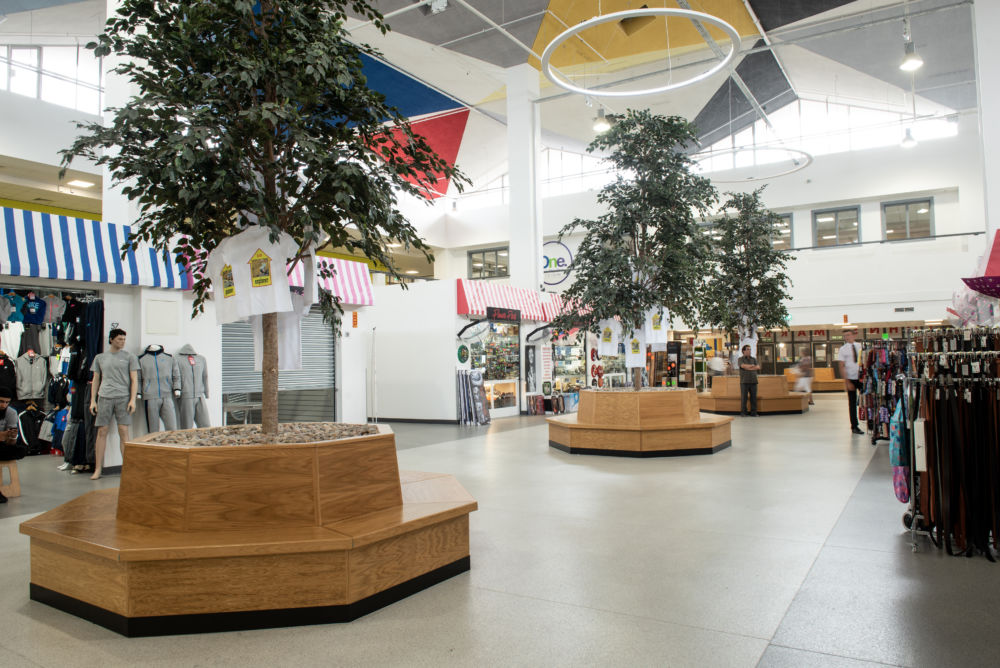The loos are flooding. The lifts don’t work. It’s so hot, you’re dizzy. Would you pay 100% of your rent?

Stalls, stalled: The St John’s Market traders bristle at the council’s demands
£2.5 million: a big sum of money for an even bigger do-over. In 2016, St John's Market — once considered one of the country's most successful markets — had seen better days. Those working there were elated when they heard the good news: the council was coming to the rescue with a hefty sum for a makeover. To give the council a nudge in the right direction, the St John's Market traders took its representatives on a whistlestop tour of various markets they might have hoped to take inspiration from: Altrincham Market, Ellesmere Port, the Bull Ring in Birmingham, even the Arndale in Manchester.
When they returned to see the finished product late that year, their faces dropped. Max Dixon, whose grandfather was first given a butcher's stall at St John’s in the 1960s, agrees to speak to me. “We left a traditional market and came back to Storage Wars,” Dixon says. “It looked like they’d developed a market around a job lot of shutters”.
Its hospital-white interior walls and harsh overhead lighting had been paired with rows of stalls cordoned off by industrial-style roller shutters. To be frank, there are nuclear power stations in rural Russia that boast more je ne sais quoi. It was hard to believe this was the after, not the before, of the big refurb.

The council had installed dozens of metal shutters where each of the various stalls was to go. Aesthetically it wasn’t great, functionally it was even worse. The metal shutters were supposed to be fitted to electric motors to help them open and close. Unfortunately, the electric motors hadn’t actually been fitted, making it a real challenge to actually get into the stalls in the morning. Or as Dixon puts it: “it’s like World’s Strongest Man trying to get them up”.
Unfortunately, a new breed of hybrid bodybuilder-butchers were not forthcoming. Nor in fact, were good old fashioned, non-bodybuilder butchers. During the refurb a number of potential tenants had been lined up, but there were no contractual obligations. Most took one look at the exciting new market and walked swiftly away.
But the real fun started when the old stall holders moved back in. First, the upstairs toilets flooded, destroying a large quantity of Jeera Husain’s Bronx clothing stock. It was never replaced. Then the toilets flooded again a couple of years later, this time wiping out £3000-£4000’s worth of stock from Ravi’s card stall. The council explained to us that Ravi was able to claim this money back on insurance.
The council believed the flooding toilet must be the fault of the traders, and so a new toilet system was implemented. While the flooded upstairs toilets were off-limits (which — at Ravi’s estimate — they have been more than a dozen times in the past few years), traders would be allowed to use the precinct’s downstairs toilets. This involved fetching a key from building security, signing in with the building managers so they knew who had used the toilets when and finally paying 20p. “It’s completely ridiculous,” Ravi says.

On top of this, the escalators giving access to the market from Elliot Street (the most obvious point of entrance) ceased to work, making it very difficult for older, less mobile people — who make up a very large portion of the clientele throughout the week — to even get in without going the long way round. Of course, the issue with the escalators might have been eased had the lifts been working. Alas, the lifts were not working. There used to be five lifts, now there are two. One of the two is touch and go.
Those who do manage to make it inside then have to contend with the unbearable temperatures, at least during the summer. The temperatures in the food aisles rose to over 40 degrees throughout the warmer months. When the council opened up their One Stop shop upstairs above the market, £60,000 was spent on air con. The One Stop shop had closed down within a year. The butchers’ aisle meanwhile continues to go without. As Ravi tells me: “you’d be quite happy to sunbathe in there”.
By 2017, the issues couldn’t be ignored any more. Then-mayor Joe Anderson paid the market a visit and conceded things weren’t looking great. By this point, it was less than 25% full and essentially flat out on its backside. A council study had revealed the market simply wasn’t feasible. It was going to make its traders bankrupt. Anderson said on Twitter (now X) that the £2.5 million revamp had “no vision” and personally pledged to get it back on its feet.
Anderson’s solution was to offer the traders free rent for three months until the council had addressed the numerous issues with the market. This seemed like a good offer, but three years later none of the issues had actually been addressed. The lifts still didn’t work. The food aisles were still stiflingly hot. Large commercial fans were rented to cool the place down in the summer, but they just blew a load of hot air in the traders’ faces. Which seemed poetic, somehow.

Despite these lack of improvements, in 2020 the council wanted some rent again. Their argument was pretty simple: that they'd gone above and beyond the original offer of three months to three years and that haemorrhaging money (£1 million a year, in fact) indefinitely probably wasn’t wise. Meanwhile the traders say they have offered to pay rent, they just can’t pay as much as the council want, because — frankly — the market is crap.
All of which brings us to the present day. A few weeks ago a letter was sent round by solicitors acting on the council’s behalf telling traders it really was time to pay up now. The council’s leader Liam Robinson went on BBC Radio Merseyside to broadcast the message: “Since the pandemic we've been in a situation where the market is costing the council a lot of money,” he said. “We need to address the big financial pressures facing the council, and this is one of them.”
Of course, a message of fiscal responsibility is what people probably want from their council, not least given the spectacular waste of the past decade or more, combined with the brutal cuts under austerity. By all accounts, and it is early days, this council is on a stronger footing on that front. And after all, most of those currently in key council positions (like Liam Robinson, or chief finance officer Andrew Lewis) didn’t actually cause this mess, they’re merely trying to mop it up. But none of that really does anything for the traders, who still have to try and scrape a living from an abomination of a market.

And no one denies that. A 2022 council-commissioned report said that St John’s had gone from “one of the most advanced [markets] in Europe” to a “largely vacant” place with “low footfall”, even despite the area around it “continuing to thrive”.
The traders also point out that they have twice offered to pay rent (roughly 35% of what the council are asking for) but any more would be unreasonable. The second of these offers was made during a legal mediation set up by the council. Combined fees for the mediator and solicitors cost the Traders Association an estimated fee between £5,000 and £6,000.
Their argument isn’t that the traders shouldn’t have to pay. It’s that they should have to pay what the market is actually worth (in fact, several say they want to start paying as they feel it will give them more bargaining power to force through some improvements). Unfortunately, from the perspective of a council trying to prevent massive losses, the amount they say it is worth (namely 35%) wouldn’t really touch the sides. Ultimately someone has to lose.

In a statement, the council added that they will discuss with traders individually “how arrears can be recovered and what assistance can be offered to each trader”. They also promised to “identify options for a more sustainable future and bring forward future proposals”.
There’s also the complication of where the buck stops for this mess. The traders reserve their ire almost exclusively for the council, but the council is actually a tenant itself, of St John’s Shopping Centre, on whom some responsibilities, like advertising the place, lie.
Rewind 10 years, Max’s butchers' stall employed seven staff. Now they’ve got two. The two that are left have worked on the market stall since leaving school. They’ve been asking Max “what are we gonna do?”. He can’t give a committed answer. Max’s grandfather would regale him with stories about the golden days at St John’s, the camaraderie between the traders, the buzzy atmosphere, not to mention the tidy profits with customers piling through. It’s hard to believe it’s come to this. Meanwhile Ravi was hoping to pass his stall on to his own son, just as his father had done for him. Now he worries about whether there'll be anything left to give.

John Burns, who owns Jacks Cafe, tells a similar story. His parents started his stall in 1984. “They had a great life there,” he says. In those days markets were community affairs — before the cafe opened at half eight, a little group of regulars would be huddled outside.
There’s still a little of that remaining, just about. When one of John’s customers had a heart attack five weeks ago, one of his staff members reached out to the lady’s grandson to check in. He was thrilled to hear from them. “He said he talks about coming here all the time,” John says proudly. “It’s a big part of people’s lives”.
It would be easy to say that this is all about online shopping washing away the human touch. To claim that pining for the days when markets were real hubs, at the centre of communities, is just misty-eyed nostalgia. It’s true that markets all over the country went into decline from the days of Max’s parents, or John’s parents, or from when Ravi was starting out. But the last decade has also seen a number of improved markets, adapted markets, markets 2.0: Barcelona, Lisbon, Bury, Altrincham. “Not everyone can shop on Amazon,” John says. “And you can’t get a coffee on Amazon”.

Last year’s council-commissioned report — entitled ‘The Future of Markets’ (optimistic to assume St John’s even has a future) — did at least acknowledge something needed to be done to bring our markets back to life. Frankly, St John’s is going to need an industrial-sized defibrillator for there to be any chance of that.
But if its traders were to humbly proffer a shopping list of requests, it would look something like this: a toilet that doesn’t constantly flood, some money back from all the stock ruined because the toilet does constantly flood, non-extortionate rents, new traders, functioning escalators, functioning lifts, functioning anything, a sign so people actually know where the market is, shutters that can be opened and closed without hitting the gym six times a week, air conditioning so the butchers aren’t perpetually on the verge of passing out, and someone to actually clean the place.
Oh, and (ideally) some shoppers. Wouldn’t that be the best improvement of all?

Comments
Latest
Merseyside Police descend on Knowsley
And the winner is...
Losing local radio — and my mum
A place in the sun: How do a bankrupt charity boss and his councillor partner afford a “luxury” flat abroad?
The loos are flooding. The lifts don’t work. It’s so hot, you’re dizzy. Would you pay 100% of your rent?
Stalls, stalled: The St John’s Market traders bristle at the council’s demands